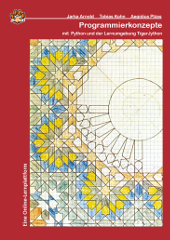Nullstellen (Kleinprojekte)
Schreiben Sie ein Programm, dass die Nullstellen einer linearen Funktion oder einer quadratischen Funktion ausgibt.
Lineare Funktion: f(x)=a*x+b
Quadratische Funktion: f(x)=a*x2+b*x+c
Der Nutzer soll vor der Eingabe entscheiden können welchen Funktionstyp er benutzen möchte.
Danach soll der Nutzer die Parameter a, b und c eingeben(c nur bei der quadratischen Funktion) und die Nullstellen sollen daraufhin ausgegeben werden.
Hinweise:
Eine lineare Funktion hat immer eine Nullstelle, außer a=0 und b!=0(Bei a=0 und b=0 gibt es unendlich viele Nullstellen!).
Eine Quadratische Funktion hat zwei, eine oder keine Nullstellen. Es gibt mehrere Möglichkeiten die Nullstellen einer quadratischen Funktion herauszufinden(z.B. pq-Formel, Mitternachtsformel). Achten Sie darauf, dass bei nur einer Nullstelle auch nur eine ausgegeben wird und nicht zweimal die gleiche angezeigt wird.
0 Kommentare
10 Lösung(en)
#include <stdio.h>
#include <math.h>
#include <stdlib.h>
float main(){
float a,b,c,x1,x2;
int typ;
printf("\nDieses Programm gibt die Nullstellen einer Funktion aus.\n\n");
printf("[1] a*x+b=0\n[2] a^2*x+b*x+c=0\n\n");
printf("Welche Gleichung?: ");
scanf("%d",&typ);
if(typ != 1 && typ != 2){
printf("Falsche Eingabe.");
return 0;
}
printf("\na = ");
scanf("%f",&a);
printf("b = ");
scanf("%f",&b);
if(typ == 2){
printf("c = ");
scanf("%f",&c);
}
if(typ == 1){
x1 = (-b)/a;
if(a == 0 && b != 0){
printf("Die Steigung ist 0. Darum gibt es keine Nullstelle.");
}
if(a == 0 && b == 0){
printf("Es gibt unendlich viele Nullstellen.");
}else{
printf("x: %f",x1);
}
}
if(typ == 2){
x1 = ((-b) + sqrtf(b*b-4*a*c))/(2*a);
x2 = ((-b) - sqrtf(b*b-4*a*c))/(2*a);
if((b*b-4*a*c) < 0 || 2*a == 0){
printf("Kein Ergebnis.");
}else{
if(x1 == x2){
printf("x: %f\n",x1);
}else{
printf("x1: %f\n",x1);
printf("x2: %f\n",x2);
}
}
}
}
Lösung von: Fynn Koch (keine)
report z_nullstellen.
type-pools abap.
data: null type i,
null2 type i,
root type i.
selection-screen begin of block b1 with frame title text-f01.
parameters linear as checkbox.
parameters quadr as checkbox.
parameters: a type i obligatory, b type i obligatory, c type i default
0.
selection-screen end of block b1.
start-of-selection.
case abap_true.
when linear.
if quadr = abap_true.
message 'Bitte für eine Funktion entscheiden!' type 'I'.
exit.
endif.
if a = 0 and b = 0.
write 'unendlich viele Nullstellen'.
elseif a = 0 and b <> 0.
write 'keine Nullstelle'.
else.
null = ( 0 - b ) / a.
write null.
endif.
when quadr.
if linear = abap_true.
message 'Bitte für eine Funktion entscheiden!' type 'I'.
exit.
endif.
if a = 0 and b <> 0.
null = ( 0 - c ) / b.
write null.
elseif a = 0 and b = 0 and c = 0.
write 'unendlich viele Nullstellen'.
elseif a = 0 and b = 0 and c <> 0.
write 'keine Nullstelle'.
else.
root = b * b - 4 * a * c.
if root < 0.
write 'keine Nullstelle'.
else.
null = ( - b + sqrt( root ) ) / 2 * a.
null2 = ( - b - sqrt( root ) ) / 2 * a.
if null = null2.
write null.
else.
write: 'erste Nullstelle: ', null, / , 'zweite Nullstelle: ',
null2.
endif.
endif.
endif.
when others.
message 'Bitte für eine Funktion entscheiden!' type 'I'.
exit.
endcase.
Lösung von: Name nicht veröffentlicht
/* Kotlin */
import java.lang.NumberFormatException
import kotlin.math.abs
import kotlin.math.sqrt
fun main() {
var type: Double
println("1: f(x)=a*x+b")
println("2: f(x)=a*x²+b*x+c")
do {
type = read("Typ auswählen")
} while (type != 1.0 && type != 2.0)
var a = read("a")
var b = read("b")
if(type == 2.0 && a == 0.0) {
type = 1.0
a = b
b = read("c")
}
when(type) {
1.0 -> {
if(a == 0.0 && b == 0.0) {
println("Es gibt unendlich viele Nullstellen!")
return
} else if(a == 0.0 && b != 0.0) {
println("Es gibt keine Nullstellen!")
return
}
val x = -b / a
println("x = %f".format(x))
}
2.0 -> {
val c = read("c")
val discriminant = b*b - 4*a*c
val alpha = -b / (2*a)
val beta = (sqrt(abs(discriminant))) / (2*a)
if(discriminant < 0) {
println("x1 = %f - %fi".format(alpha, beta))
println("x2 = %f + %fi".format(alpha, beta))
} else {
val x1 = alpha - beta
val x2 = alpha + beta
if(x1 == x2) {
println("x = %f".format(x1))
} else {
println("x1 = %f".format(x1))
println("x2 = %f".format(x2))
}
}
}
}
}
fun read(s: String): Double {
print("%s: ".format(s))
return try {
readLine()!!.toDouble()
} catch (e: NumberFormatException) {
println("Fehler: Keine Zahl")
read(s)
}
}
Lösung von: Name nicht veröffentlicht
/* GOLANG */
package main
import (
"bufio"
"fmt"
"math"
"os"
"strconv"
)
func readParam(readA bool, readB bool, readC bool) (a float64, b float64, c float64, err error) {
var read string
if readA {
fmt.Print("a=")
_, err = fmt.Scanf("%s\n", &read)
a, _ = strconv.ParseFloat(read, 64)
}
if readB {
fmt.Print("b=")
_, err = fmt.Scanf("%s\n", &read)
b, _ = strconv.ParseFloat(read, 64)
}
if readC {
fmt.Print("c=")
_, err = fmt.Scanf("%s\n", &read)
c, _ = strconv.ParseFloat(read, 64)
}
return a, b, c, err
}
func main() {
reader := bufio.NewReader(os.Stdin)
fmt.Println("Choose equation type:")
fmt.Println("Type - 1 - for linear ( f(x) = a*x=b )")
fmt.Println("Type - 2 - for quadratic ( f(x) = ax^2 + bx + c)")
equationType, _, err := reader.ReadRune()
if err != nil { os.Exit(1) }
switch equationType {
case '1':
a, b, _, err := readParam(true, true, false)
if err != nil {
fmt.Println(err)
os.Exit(1)
}
if a == 0 {
if b != 0 {
fmt.Println("No zero")
} else {
fmt.Println("Zero for every x")
}
os.Exit(0)
} else {
x := -b / a
fmt.Printf("x = %f\n", x)
}
break
case '2':
a, b, c, err := readParam(true, true, true)
if err != nil {
fmt.Println(err)
os.Exit(1)
}
det := math.Pow(b, 2) - 4 * a * c
if det < 0 {
fmt.Println("No real solutions")
} else if det > 0 {
fmt.Println("Two Solutions in R: ")
x := (-b + math.Sqrt(math.Pow(b, 2) - 4 * a * c))/ (2 * a)
fmt.Printf("%f\n", x)
x = (-b - math.Sqrt(math.Pow(b, 2) - 4 * a * c))/ (2 * a)
fmt.Printf("%f\n", x)
} else {
fmt.Println("One Solution in R: ")
x := -b / (2*a)
fmt.Printf("%f\n",x)
}
}
}
Lösung von: Name nicht veröffentlicht
/**
* Eine lineare Gleichung ist ein Spezialfall einer quadratischen Gleichung ax² + bx + c
* <=> wenn a = 0. Eine Gleichung besitzt immer genau so viele Nullstellen, wie der Grad
* ihrer höchsten Potenz. Die Formel zum Ermitteln der Nullstellen einer quadr. Gl. lautet:
* {-p/2 +/- sqrt((p/2)^2 - q)} mit p = b/a und q = c/a unter der Bedingung a ? 0 .
*
* @author Carsten Krahl
*/
public class Launcher {
public static void main(String[] args) {
double nst[] = nullstellen( -1, 1, 1 );
boolean isNonLinear = nst.length == 2; // prüfe auf quadr. Funktion
boolean nst_exists = (isNonLinear) && // Gibt es eine od. mehrere Nullstellen?
!(Double.isNaN( nst[0] ) && Double.isNaN( nst[1] )) ||
!(isNonLinear || Double.isInfinite( nst[0] )); // <=> !A && !B
boolean nst_notequal =
(isNonLinear) && (!(nst_exists) || !( nst[0] == nst[1] )) ? true : false;
System.out.println(( nst.length == 1 ) ?
"Die Nullstelle der linearen Gleichung ist: "+
((nst_exists) ? nst[0] : "nicht vorhanden" ) :
"Die Nullstellen der quadratischen Gleichung sind: "+
((nst_exists) ? ((nst_notequal) ? nst[0] +", "+ nst[1] : nst[0]) : "nicht vorhanden" ));
}
public static double[] nullstellen( double a, double b, double c ) {
double p = 0;
double q = 0;
if ( a != 0 ) {
p = b/a;
q = c/a;
}
return (a == 0) ?
new double[]{ -c/b } :
new double[]{ -p/2 - Math.sqrt( p*p/4 -q ), -p/2 + Math.sqrt( p*p/4 -q )};
}
}
Lösung von: Carsten Krahl (BA Leipzig)
#Lösung der Aufgabe mit GUI
import tkinter as tk
import math
def calc():
if choose.get() == 1: #quadraitsich Funktion
a = int(a_entry.get())
b = int(b_entry.get())
c = int(c_entry.get())
try:
x1 = round((-b + math.sqrt(b**2-4*a*c))/(2*a),5)
x2 = round((-b - math.sqrt(b**2-4*a*c))/(2*a),5)
result =str("x1 = {0}\n x2 = {1}".format(x1, x2))
erg.config(text = result)
except:
erg.config(text = "Keine Lösung\nÜberprüfen Sie Ihre Eingaben")
else:
a = int(a_entry.get())
b = int(b_entry.get())
if a == 0 and b == 0:
erg.config(text = "Bei a = 0 und b = 0, gibt es unendlich viele Nullstellen")
return
elif a == 0 and b !=0:
erg.config(text = "Steigung ist 0 ==> Keine Nullstelle")
else:
x1 = round(-b/a)
result = str("x1 = {}".format(x1))
erg.config(text = result)
def disable():
if choose.get() == 0:
c_entry.config(state = "disabled")
else:
c_entry.config(state = "normal")
main = tk.Tk()
choose = tk.IntVar()
choose.set(0)
choose_gleichung_linear = tk.Radiobutton(main, text = "Lineare Gleichung", variable = choose, value = 0, command = disable)
choose_gleichung_linear.grid()
choose_gleichung_quadrat = tk.Radiobutton(main, text = "Quadratische Gelichung", variable = choose, value = 1, command = disable)
choose_gleichung_quadrat.grid()
al = tk.LabelFrame(main, text = "a")
al.grid()
bl = tk.LabelFrame(main, text = "b")
bl.grid()
cl = tk.LabelFrame(main, text = "c")
cl.grid()
a_entry = tk.Entry(al)
a_entry.grid()
b_entry = tk.Entry(bl)
b_entry.grid()
c_entry = tk.Entry(cl, state = "disabled")
c_entry.grid()
but = tk.Button(main, text = "Rechne", command = calc)
but.grid()
erg = tk.Label(main, text = "")
erg.grid()
main.mainloop()
Lösung von: Py Thon ()
clc
gleichung = input("lineare(1) oder quadratische(2) Gleichung? ")
if gleichung == 1 then
disp("f(x)=ax+b")
a = input("a= ")
b = input("b= ")
x = -b/a
disp("x = ")
disp(x)
elseif gleichung == 2 then
disp("f(x)=ax^2+bx+c")
a = input("a= ")
b = input("b= ")
c = input("c= ")
x1 = -b/2/a + sqrt(b^2/4/a^2 - c/a)
x2 = -b/2/a - sqrt(b^2/4/a^2 - c/a)
if x1 ~= x2 then
disp("x1 = ")
disp(x1)
disp("x2 = ")
disp(x2)
else
disp("x1 = ")
disp(x1)
end
end
//Scilab
Lösung von: Name nicht veröffentlicht
function zeros(a, b, c) {
if (!c) {
// lineare gleichung
if (a == 0 && b == 0) return Infinity;
if (a == 0 && b != 0) return [];
return -b / a;
} else {
// quadratische gleichung
let x1 = (-b - Math.sqrt(b ** 2 - 4 * a * c)) / 2 * a,
x2 = (-b + Math.sqrt(b ** 2 - 4 * a * c)) / 2 * a
if (x1 == x2) return x1;
else return [x1, x2];
}
}
Lösung von: Lisa Salander (Heidi-Klum-Gymnasium Bottrop)
// NET 6.x | C# 6.x | VS-2022
IEnumerable<object> Zeros(params double[] p) {
switch (p.Length) {
case 2: yield return (p[0], p[1]) switch { (0, 0) => "infinity", (0, _) => "nothing", (_, _) => -p[1] / p[0] }; break;
case 3: var x = (int i) => -p[1] + i * Math.Sqrt(p[1] * p[1] - 4 * p[0] * p[2]) / (2 * p[0]);
double x1 = x(-1), x2 = x(1);
yield return x1;
if (x1 != x2) yield return x2; break;
default: yield return "nothing"; break;
}
}
Lösung von: Jens Kelm (@JKooP)
// C++ 17
#include <iostream>
#include <string>
#include <optional>
std::string get_zeros(double a, double b, std::optional<double> c = std::nullopt) {
if (c) {
const auto x{ [&](auto i) {return (-b + i * sqrt(b * b - 4 * a * *c) / (2 * a)); } };
const auto x1{ x(-1) }, x2{ x(1) };
return (x1 == x2) ? std::to_string(x1) : std::to_string(x1) + ", " + std::to_string(x2);
}
if (!a) { return b ? "Nothing" : "Infinity"; }
return std::to_string(-b / a);
}
Lösung von: Jens Kelm (@JKooP)
Aktionen
Neue Lösung hinzufügen
Bewertung
Durchschnittliche Bewertung:




